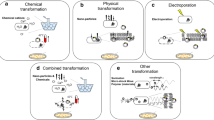Abstract
The genes encoding purine nucleoside phosphorylase (PNPase), uridine phosphorylase (UPase), and thymidine phosphorylase (TPase) from Escherichia coli K12 were cloned respectively into expression vector pET-11a or pET-28a. The recombinant plasmids were transformed into the host strain E. coli BL21(DE3) to construct four co-expression recombinant strains. Two of them had double recombinant plasmids (DUD and DAD) and the other two had tandem recombinant plasmid (TDU and TDA) in them. Under the repression of antibiotic, recombinant plasmids stably existed in host strains. Enzymes were abundantly expressed after induction with IPTG and large amount of target proteins were expressed in soluble form analyzed with SDS-PAGE. Compared with the host strain, enzyme activity of the recombinant strains had been notably improved. In the transglycosylation reaction, yield of 2,6-diaminopurine-2’-deoxyriboside (DAPdR) from 2,6-diaminopurine (DAP) and thymidine reached 40.2% and 51.8% catalyzed by DAD and TDA respectively; yield of 2,6-diaminopurine riboside (DAPR) from DAP and uridine reached 88.2% and 58.0% catalyzed by TDU and DUD respectively.





Similar content being viewed by others
References
Ershler, B. W. (2006). Capecitabine use in geriatric oncology: an analysis of current safety, efficacy, and quality of life data. Critical Reviews in Oncology/Hematology, 58, 68–78. doi:10.1016/j.critrevonc.2005.08.006.
Sarafianos, S. C., Hughes, S. H., & Arnold, E. (2004). Designing anti-AIDS drugs targeting the major mechanism of HIV-1 RT resistance to nucleoside analog drugs. The International Journal of Biochemistry & Cell Biology, 36, 1706–1715. doi:10.1016/j.biocel.2004.02.027.
Anglada, M. P., Soldado, P. C., Arcas, M. M., Lostao, M. P., Larr’ayoz, I., Picado, J. M., & Casado, F. J. (2005). Cell entry and export of nucleoside analogues. Virus Research, 107, 151–164. doi:10.1016/j.virusres.2004.11.005.
Utagawa, T. (1999). Enzymatic preparation of nucleoside antibiotics. Journal of Molecular Catalysis. B, Enzymatic, 6, 215–222. doi:10.1016/S1381-1177(98)00128-3.
Zhang, S. T., Ni, M. X., & Ruan, Q. P. (2005). Enzymatic synthesis of nucleoside drugs. Progress in Pharmaceutical Sciences, 29, 56–62.
Bzowska, A., Kulikowska, E., & Shugar, D. (2000). Purine nucleoside phosphorylases: properties, functions, and clinical aspects. Pharmacology & Therapeutics, 88, 349–425. doi:10.1016/S0163-7258(00)00097-8.
Pugmire, M. J., & Ealick, S. E. (2002). Structural analyses reveal two distinct families of nucleoside phosphorylases. The Biochemical Journal, 361, 1–25. doi:10.1042/0264-6021:3610001.
Nagata, T., Nakamori, M., Iwahashi, M., & Yamaue, H. (2002). Overexpression of pyrimidine nucleoside phosphorylase enhances the sensitivity to 5’-deoxy-5-fluorouridine in tumour cells in vitro and in vivo. Eur J Cancer, 38, 712–717. doi:10.1016/S0959-8049(01)00469-5.
O’Donovan, G. A., & Neuhard, Y. (1970). Pyrimidine metabolism in microorganisms. Bacteriological Reviews, 34, 278–343.
Jensen, K. F., & Nygaard, P. (1975). Purine nucleoside phosphorylase from Escherichia coli and Salmonella typhimurium. Purification and some properties. European Journal of Biochemistry, 51, 253–265. doi:10.1111/j.1432-1033.1975.tb03925.x.
Kremlitsky, T. A., Koszalska, G. W., & Tuttle, J. V. (1981). An enzymic synthesis of purine D-arabinonucleosides. Carbohydrate Research, 97, 139–146. doi:10.1016/S0008-6215(00)80531-5.
Walton, L., Richards, C. A., & Elwell, L. P. (1989). Nucleotide sequence of the Escherichia coli uridine phosphorylase gene. Nucleic Acids Research, 17, 6741. doi:10.1093/nar/17.16.6741.
Sambrook, J., & Fritsch, E. F. (1989). Molecular Cloning: a laboratory manual (2ndnd ed.). New York: Cold Spring Harbor Laboratory.
Zhang, Y. K., Li, T. M., & Liu, J. J. (2003). Low temperature and glucose enhanced T7 RNA polymerase-based plasmid stability for increasing expression of glucagons-like peptide-2 in Escherichia coli. Protein Expression and Purification, 29, 132–139. doi:10.1016/S1046-5928(03)00002-0.
Kalckar, H. M. (1947). Differential spectrophotometry of purine compounds by means of specific enzymes. III. Studies of the enzymes of purine metabolism. Journal of Biochemistry, 167, 461–475.
Bergmeyer, H. U., Gawehn, K., & Grassl, M. (1974). Methods of enzymatic analysis (2ndnd ed.). New York: Academic.
Thomas, A. K., Joel, V. T., & George, W. K. (1976). Deoxycytidine Kinase from Calf Thymus: substrate and inhibitor specificity. Journal of Biochemistry, 251, 4055–4061.
Colowick, S. P., & Kaplan, N. O. (1955). Method in enzymology II. New York: Academic.
Phyllis, R. B. (1984). HPLC in nucleic acid research: Methods and applications. Boca Raton: CRC.
Esipov, R. S., Gurevich, A. I., Chuvikovsky, D. V., Chupova, L. A., Muravyova, T. I., & Miroshnikov, A. I. (2002). Overexpression of Escherichia coli genes encoding nucleoside phosphorylases in the pET/Bl21(DE3) system yields active recombinant enzymes. Protein Expression and Purification, 24, 56–60. doi:10.1006/prep.2001.1524.
Moore, J. T., Uppal, A., Maley, F., & Maley, G. F. (1993). Overcoming inclusion body formation in a high-level expression system. Protein Expression and Purification, 4, 160–163. doi:10.1006/prep.1993.1022.
M’edici, R. (2006). Lewkowicz ES, Iribarren AM. Microbial synthesis of 2,6-diaminopurine nucleosides. Journal of Molecular Catalysis. B, Enzymatic, 39, 40–44. doi:10.1016/j.molcatb.2006.01.024.
Author information
Authors and Affiliations
Corresponding author
Rights and permissions
About this article
Cite this article
Ge, C., OuYang, L., Ding, Q. et al. Co-Expression of Recombinant Nucleoside Phosphorylase from Escherichia coli and its Application. Appl Biochem Biotechnol 159, 168–177 (2009). https://doi.org/10.1007/s12010-008-8429-3
Received:
Accepted:
Published:
Issue Date:
DOI: https://doi.org/10.1007/s12010-008-8429-3




